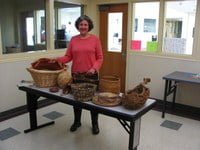Weaving Nature and Art Helps Give Sense of Self to Young Women in Prison
by Tom Kaye — last modified Apr 30, 2013
The Burden Basket Project at Oakcreek Youth Correctional Facility

The Sustainability in Prisons Project of the Institute for Applied Ecology (IAE) is helping give a sense of self to a most vulnerable, yet hopeful population – the young women inmates at the Oak Creek Youth Correctional Facility in Albany, Oregon. Back in 2012, Oak Creek invited IAE to give classes to these young women by providing hands-on engaging experiences with plants, soil and wildlife. Though there have been many highlights throughout, the weaving of Native American burden baskets held a special place.
Through weaving nature, art and tradition into the science classroom setting, Stacy Moore, IAE’s Ecological Education Program Director, taught the young women the ancient art of weaving ‘burden’ baskets — baskets made from native plant materials — that were once used by Native American tribes for everyday use in carrying fire wood and in gathering wild foods.
Stacy harvested rushes, sedges, Douglas-fir and lichen from her land for the burden baskets. As the women carefully wove the native plant materials into decorative patterns, and watched their burden baskets grow from their hands and hearts and minds, their sense of self and place in history began to evolve.
“My goal for the women was to develop an appreciation for nature while engaging in a creative outlet. But the thing that really impacted me was how they embraced not only their artistic voice, but also all of their senses. They observed and shared how beautiful the fir boughs smelled, how soft the lichen felt and commented on the texture of the rushes, along with the soothing colors. I was so impressed with how they responded to the experience with their senses coming alive.”
Deborah Clark, IAE’s Board President, has experienced working first-hand with the students. This project was particularly significant to her.
“You could see the joy the women experienced in weaving their own basket. I brought my baskets from Alaska, Oregon and Africa, so they could see a variety of basket weaving techniques and materials used in different cultures. You never know how a connection with the natural world will impact someone, but I believe we are making a difference.”
The cultural and historical significance of the burden baskets also served as an important backdrop to this complex and beautiful project. IAE’s native plant curriculum for the basket provided these words: “For millennia, people used plant fibers to meet the needs of daily life. Traditionally, plant fiber played a large role in many cultures, but with the proliferation of manmade materials like plastics, this need has diminished as have the skills that go with it. Although modern society still depends on plants to supply fiber for paper and cloth, much has changed in just the last couple of centuries, making our relationship with the plants around us very different than it once was.”
The historical struggles in daily life and survival for Native Americans was embraced and felt by the students. “The girls were captivated by how difficult it was to make the burden baskets. This gave them a new gratefulness for the work the Native Americans had to do in their daily life, just to survive. They realized how historically, people had to make their own products by hand, whereas today we simply go to the store, buy products, and then discard them. I believe this project helped give these young women a sense of their value and place in history through crafting their own unique burden basket,” said Stacy.
These young women were very proud of the burden baskets they created, and so was their Oak Creek Science teacher Ben Sharvy. He displayed their baskets in the Oak Creek Staff Lounge, where all could admire the students’ beautiful craftsmanship.
Currently, these young women are reaching out into their communities and helping to bring nature into the lives of other young people. As part of IAE’s ecological restoration projects with middle schools (in Corvallis, Philomath and Kings Valley), the women inmates are growing native plants such as Riverbank lupine, Nelson’s checkermallow and self-heal in their greenhouse, and providing the plants to middle school students for use at restoration sites at Jackson-Frazier Wetland and the Evergreen Creek property.

IAE would like to give thanks to the Oak Creek Youth Correctional Facility and Willamette Habitat Restoration for their generosity and continued support of the educational projects for the women inmates at Oak Creek. These funds will allow us to continue our exploratory work and science enrichment with these students.
